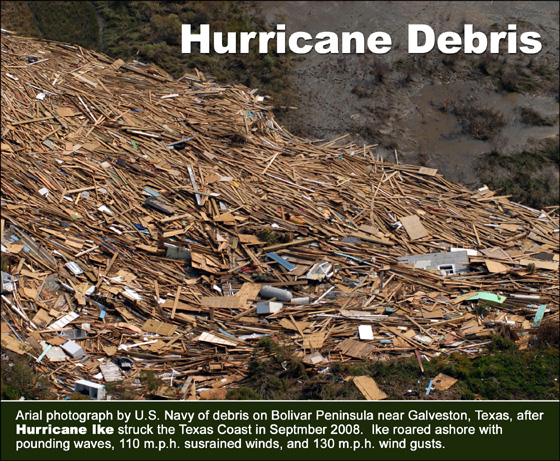The Daunting Task of Debris Removal after Cyclonic Storms
It is hard to wrap your mind around the scope of hurricane clean up.
At first, just surviving day-by-day, crisis by crisis takes everyone’s full attention after a hurricane. Then reality sets in. Rebuilding cannot begin until the rubble left behind is removed.
What do you do with the great piles of rubbish created by a major storm?
 The Debris Crisis
The Debris Crisis
The sheer size of debris created by strong tropical storms and hurricanes seems insurmountable.
Powerful hurricanes destroy property and landscape by fierce winds, violent tornadoes, flooding rainfall, storm surges, and pounding waves. As the storms sweep inland, they grind vegetation, vehicles, and weaker structures into splintered rubble.
Hurricane debris includes all types of building materials, electronic devices, furniture and household items, major appliances, personal items, road surface materials, and just plain trash like spoiled food. “Green waste” consists of shredded and broken grass, plants, shrubs and trees. Hazardous waste from asbestos, chemicals, cleaning supplies, insecticides, oil, paint, and the like require special handling and care.
These figures reveal just an inkling of the overwhelming task of hurricane clean up:
Hurricane HUGO smashed ashore in Charleston, North Carolina in 1989. Hugo toppled 80,000 trees in Charleston. Hugo produced 18 million cubic feet of debris in Charleston— an estimated 200,000 dump truck loads.
In Mecklenburg County, North Carolina— 200 miles from Charleston— Hugo created over 400,000 tons of shredded trees, shrubbery, and landscaping— ten years of green waste generated in just three hours! It took 16 months to complete mulching the vegetation as part of the hurricane clean up.
Hugo annihilated 70% of the trees on the Francis Marion National Forest in South Carolina— six billion board feet of lumber was lost.
Hurricane ANDREW shattered Dade County, Florida in August 1992. Andrew generated 387 million cubic feet of debris in Dade County alone. Andre demolished over 150,000 homes and thousands of businesses. Dade County mulched 500,000 tons of splintered trees and wood.
Hurricane Andrew’s entire debris field covered 500 square miles.
Hurricane INIKI chewed across the tiny island of Kauai in Hawaii in September 1992. Iniki produced 45 million cubic feet of debris. That’s equivalent to seven years of Kauai’s normal refuse collection.
Hurricane KATRINA produced a debris field covering over 90,000 square miles in 2005! Katrina generated an estimated 855 million square feet of debris. That astounding figure does not include the additional construction and demolition waste produces as a natural part of rebuilding.
Hurricane IKE generated so much debris on the Bolivar Peninsula near Galveston, Texas, that FEMA (Federal Emergency Management Agency) provided Galveston County with a $15.7 million hurricane clean up grant. (See photo above.)
Hurricane SANDY, the largest storm every recorded in the Atlantic Ocean, pounded New York and New Jersey in 2012. Sandy left 55.8 million cubic feet of debris in her wake. That is about seven years of normal landfill space.
New York debris removal after Sandy cost the city about $100 per cubic yard!
RHINO Steel Buildings: Built Strong to Last Long
Building stronger structures in hurricane-prone areas starts with sturdy, dependable, hurricane-resistant steel buildings.
Pre-engineering means RHINO steel buildings deliver strong structures built to last— even in coastal areas.
RHINO designs structures with wind loads as high as 170 m.p.h. or more for hurricane-prone regions. Our buildings will meet or exceed every present-day building code— even in Dade County, Florida— guaranteed for the LIFETIME of the structure.
Call RHINO now at 940.383.9566 for more information on hurricane-resistant metal buildings. Get a RHINO quote for your next low-rise commercial and industrial project in a hurricane-prone area.
